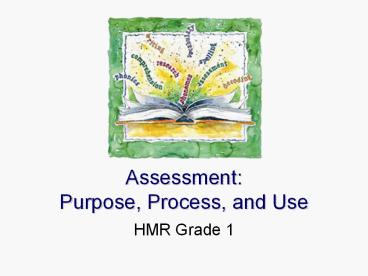Assessment: Purpose, Process, and Use - PowerPoint PPT Presentation
1 / 50
Title:
Assessment: Purpose, Process, and Use
Description:
Assessment: Purpose, Process, and Use HMR Grade 1 Without data, all anyone has is an opinion. W. Edwards Deming Ideally, assessment and instruction are ... – PowerPoint PPT presentation
Number of Views:97
Avg rating:3.0/5.0
Title: Assessment: Purpose, Process, and Use
1
AssessmentPurpose, Process, and Use
- HMR Grade 1
2
Introduction to the Assessment Training
3
- Without data, all anyone has is an opinion.
- W. Edwards Deming
4
- Ideally, assessment and instruction are linked
inextricably within any curriculum. The key to
using assessment effectively and efficiently in a
program of instruction is to recognize above all
that different types of assessment tools must be
used for different purposes. - From Reading/Language Arts Framework for
California Public Schools
5
Six Key Elements
6
Six Key Elements
- All classrooms deliver a coherent academic
program. This includes specific content and an
instructional system that is well supported with
high quality materials and training.
1.
7
Six Key Elements
- Everyone at the school uses a frequent
assessment system directly connected to the
content of the academic program. This system is
designed to be used to improve instruction.
2.
8
Six Key Elements
- All persons work in collegial, collaborative
school and grade level teams that focus on
developing successful, program-specific
strategies to improve achievement for all
students.
3.
9
Six Key Elements
- The school engages in content-specific,
site-based professional development with coaching
and technical support. Activities are developed
using the data generated by the ongoing,
program-specific assessment system and are
focused on improving instruction for all students.
4.
10
Six Key Elements
- The schools active and knowledgeable leadership
takes actions focused on developing and
strengthening the academic performance of ALL
students in the agreed academic area.
5.
11
Six Key Elements
- The district provides coherent, coordinated
support and leadership that technically assists
the school to focus work and sustain specific
improvements in achievement over time.
6.
12
Three Types of Assessments
- Screening/Entry Level
- Monitoring
- Outcome/Summative
13
Teacher and Student Materials
14
The Assessment Program
15
Skills Assessments
16
The LastSkills Assessment
The last Theme Skills Assessment completed for
Grade 1 is also considered appropriate for
measuring some key content standards.
17
Overview ofSkills Assessments
18
Answer Keyand Directions
19
Content and Rationale Spelling
20
Learning from Errors
21
Answers Themes 1 2 Spelling
Assessing
short o and a, and /d/ and /t/ short o and u,
vowels in words short e and i, vowels in
words short e and u, vowels in words short o and
u, vowels in words
22
Answers Themes 1 2 Spelling
Assessing
short i and o, vowels in words short a and i, and
/n/ and /m/ short a and i, vowels in words short
o and e, vowels in words short u and e, and /m/
23
Themes 7 8 Spelling
24
Answers Themes 7 8 Spelling
Assessing
long o spelled oa, ow (spelling word p. T26) hard
and soft c, u_e oo ow igh
25
Answers Themes 7 8 Spelling
Assessing
doubling consonant when adding inflectional
ending to short vowel word homophones oo adding
inflectional endings to long vowel word and ee ou
26
Content and Rationale Word Reading,
Comprehension
27
Content and Rationale Writing
28
Classroom Writing Assessment Report
29
Content and Rationale Fluency
30
Marking Fluency Passages
31
Themes 7 8Fluency Passages
32
The Key to Reading Success
The first grade program supports fluency in
second grade by ensuring students have
- Automaticity of Sounds to Letters
- Automaticity of High Frequency Words
- Automaticity in Decoding/Blending
33
Oral Reading Fluency Norms
34
How Many Minutes?
How many minutes does each student read aloud
every day in your classroom?
It is recommended that every child read aloud in
class 20-30 minutes every day.
35
Curriculum-Embedded Assessment
- A curriculum-embedded assessment system is
essential to determining effectiveness of
instruction and student progress. To impact
student achievement, data analysis must be
examined both vertically and horizontally.
36
Looking at the Data
37
Look at Vertical Data
38
Look at Horizontal Data
39
Analyzing Assessment Data
40
Look at the Vertical Data
- Look vertically at the class scores for that
monitored skill. - Note percentage of students scoring at or above
benchmark in that column. - Reflect on ways to improve instruction if more
than 10 of students score below benchmark.
41
Next Steps
- Formulate a plan
- Tackle one skill at a time
- Determine if more support is needed
42
Look at the Horizontal Data
- Student Groups
- Preteaching
- Support
- Intervention
- Accelerated/challenge
43
Universal Access
44
Identifying Students for Intervention
45
Analyzing Assessments Horizontally
46
Its All About the Teaching
- We must provide high-quality teaching with
fidelity to the core to ensure student success in
every classroom.
47
Reflecting on Instruction
- Has Direct Instruction been used?
- Has the lesson been properly scaffolded?
- Has the material been judiciously reviewed?
- Has student engagement been monitored?
48
End-of-YearAssessment
49
Next Steps
- Formulate a plan to address instructional
challenges to improve student achievement. - Tackle one skill area or concept at a time.
- Should help from a coach, mentor teacher, or
grade-level team member be solicited? - Would it be helpful to have the coach or
principal provide an inservice or lead a lesson
study?
50
Five Step Process
- Teachers administer the assessments and collect,
record, and chart the vertical and horizontal
data. - The school meets as a whole faculty to establish
the process of using data to improve instruction. - Team meetings are held to examine data and to
agree on instructional improvements. - The whole school meets to share action plans
across grade levels and to develop a site-based
staff development plan. - The school continues to conduct ongoing team
meetings/lesson studies to support improved
instruction based on a written action plan.































